It's All Greek to Me: A Return to Greece
From Tunisia, I took a 2 hour nonstop flight to Athens, Greece to meet up with the rest of my work colleagues for a 10-day journey throughout Athens, Santorini, Chania, and Arcadia. Because the nonstop flights don't operate every day, I ended up arriving in Athens two days early. While my flight was originally supposed to depart at 10 AM, it got pushed back to 5 PM which worked out in my favor because I wouldn't have been able to return to the Tunis medina otherwise. However, that meant I arrived in Greece pretty late...
 |
| Flying into Greece. |
 |
| Landing in Athens. |
When I landed, I checked my carry on bag into one of the lockers to store it (since I had purchased fragile items in Tunsia) and by the time I arrived to my hotel, it was already 9:30 PM. See below for a quick property/room tour.
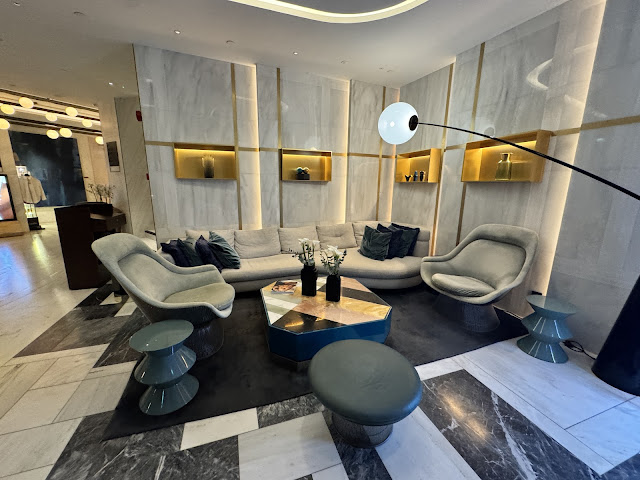 |
| Lobby area. |
 |
| Lobby area. |
 |
| Walking to the room. |
 |
| Bedroom. |
 |
| The bathroom was really cool! |
 |
| The shower also opened to the room. |
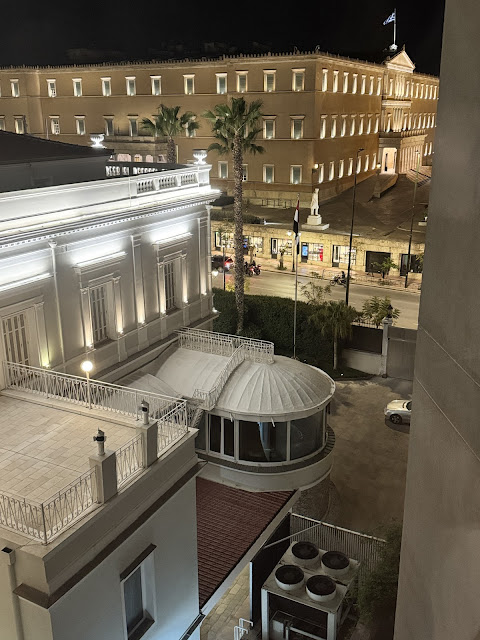 |
| View from the room. |
Arriving late didn't stop my friend and I from going out, though! I quickly dropped my bags in my room and we set off for a highly recommended souvlaki restaurant. When we got there, we told the owner his restaurant came highly recommended and he asked us what we wanted. We asked him what he recommended, and he proceeded to point to different menu items and said we should get all of it. Being in Greece, we said ok. It didn't disappoint!
Even with it being so late at night, the place was packed, and the pedestrian street was lined with locals and tourists alike. By 11 PM, we walked back to the hotel exhausted, stopping for some quick photos at Mitropoleos Square, home to the cathedral church of the Archbishop of Athens and all Greece.
The following morning, we checked out the rooftop area of the hotel...
...And then got ready for our cooking class! We set off on foot once more, iPhone map in hand. After about 15 minutes, we made it to The Greek Kitchen, an adorable chef's kitchen located on the second story of a building right around the corner from the Athens Central Market.
After meeting everyone and getting situated, we walked to the Athens Central Market, also known as Varvakios Agora (in honor of Ioannis Varvakis, a wealthy Greek benefactor). Situated on Athinas Street, the market spans several blocks between the Monastiraki and Omonia neighborhoods. Established in 1886, it offers a sensory feast of sights, sounds, and aromas. Like most central markets, it is divided into distinct sections for meat, fish, vegetables, fruits, and speciality shops.
We entered at the meat section, where there are full animal carcasses and butchered cuts hanging from hooks in open-air stalls. This section is very traditional and rustic, selling everything from lamb and beef to goat and speciality meats.
We then walked to the fish market, one of the busiest in Greece, which offers a huge variety of fresh seafood including octopus, squid, sardines, shrimp, and sea bream.
We continued on to the vegetable and fruit stalls, outside the main market hall. Sourced from local Greek farms, the stalls sell fresh herbs, local greens, seasonal fruits, and vegetables at low prices but very high quality.
Among these shops are the speciality shops featuring herbs, local cheeses, barrels of olives, jars of honey, dried nuts, sweets, and more.
Once we picked up the ingredients, we walked back to the kitchen to begin our 5-hour cooking class.
We began by making dolmades (stuffed grape leafs) that at a glance looks difficult but is actually quite easy once you get the hang of it.
Trimming the stem, you lay a grape leaf flat on a cutting board and place one teaspoon of filling near the base of the leaf. The trick is to place the rice in the leaf uncooked, as it expands while it cooks.
To fold, you fold both corners towards the middle of the leaf (as if you're making an envelope), and then tightly roll the leaf from bottom to top, like a mini burrito.
You then place the rolled leaf seam-side down in the cooking pot (the bottom of which is lined with extra grape leaves to prevent burning), and snugly pack the leaves in to prevent unrolling during cooking.
After our dolmades went in the pot, we began making spanakopita, which was probably the easiest dish to make. Instead of the traditional sheet pan, we made little individual rolls so we placed our filling (a mixture of herbs and cheese), at the edge of our phyllo dough, folded the dough loosely like a burrito, and then spiraled it, brushing the top with a little butter.
 |
| Getting ready to roll the spanakopita. |
 |
| We marked our spanakopitas with a decoration to know which was ours. |
Of course, we also had to make tzatziki, the Greek yogurt dip with garlic and cucumber! We then made imam baldi, a delicious mix of roasted eggplant in a sweet and sour sauce topped with feta cheese. Stirring ingredients together, we then stuffed eggplants and topped them with cherry tomatoes.
For dessert, we made portokalopita, a sticky orange pie made from "phyllo confetti" (literally, shredded phyllo dough), orange zest, and cinnamon. By the end of the class, we were exhausted (and hungry). We put our food out family style and enjoyed our Greek meal together. Photos below!
When the class finished, it was raining hard. We went back to the Central Market to shop for some oregano and ducked into a coffee shop to wait out the rain where we just so happened to see one of the couples who joined our cooking class. We sat and talked for awhile before heading back to our hotel, where I had previously stayed in 2019. To my surprise, I was upgraded to a suite complete with champagne, sweets, a butler, and a 150th anniversary beach towel... talk about spoiled! See below for some room photos.
 |
| The living room. |
 |
| The bedroom. |
 |
| Champagne and sweets on the table! |
 |
| View from the bedroom window. |
 |
| View from the living room window. |
After a tour of the hotel and some different room categories we enjoyed dinner at Tudor Hall, a Michelin starred rooftop restaurant. The menu features a contemporary take on Greek cuisine, blending traditional flavors with modern techniques. Here, we had a Santorini salad with cheese and caper leaves, sea bass carpaccio, sea bass with steamed seasonal vegetables, and a selection of desserts, all with the Acropolis as our backdrop. Some photos below.
The following day, we had breakfast on the rooftop overlooking the Acropolis and Parliament building before we had a tour of the Acropolis.
 |
| View from breakfast. |
We began at the Theatre of Dionysus, considered to be the birthplace of theater. Dedicated to the god of wine and theater, famous plays by Aeschylus, Sophocles, Euripides, and Aristophanes were performed here with a capacity of up to 17,000 spectators.
As we neared the Temple of Athena Nike and the Propylaea (the monumental gateway to the Acropolis), I looked down into the Ancient Agora of Athens. Once the center of political, commercial, social, and cultural life in classical Athens, it was a bustling public space where citizens gathered to discuss politics, shop at markets, attend religious ceremonies, and participate in philosophical and civic life.
Entering the Propylaea, an imposing entrance with both Doric and Ionic columns, we made our way to the Erechtheion which, after two visits, still remains my favorite structure on Acropolis hill. The multi-level temple was named after Erechteus, a legendary king of Athens, who was believed to be buried there. The building stands on sacred ground where, according to myth, the gods Athena and Poseidon competed for patronage of the city of Athens. Poseidon struck the ground with his trident, producing a saltwater spring or a horse (depending on the version) and Athena responded by planting the first olive tree. The citizens chose Athena's gift as more valuable to the city, and she became the city's patron deity. The spot where this contest supposedly occurred, and where Poseidon's trident struck the rock, is inside the Erechteion.
One of the temple's most iconic elements is the Porch of the Caryatids where six sculpted female figures support the roof. Elegant and lifelike, they represent the ideal Athenian woman and demonstrate incredible artistic skill. Unfortunately, one of the figures were taken by Lord Elgin in the 19th century and is now in the British Museum. The remaining five are in the Acropolis Museum, replaced on-site by replicas.
From there, we visited the Parthenon, perhaps the most iconic structure on the Acropolis of Athens. Built between 447 and 432 BCE, it was dedicated to Athena Parthenos, the patron goddess of the city, and once housed a colossal gold-and-ivory statue of Athena crafted by the sculptor Phidias. Designed with perfect proportions and intricate sculptural details, the Parthenon represents the height of classical architecture, democratic ideals, and Athenian cultural pride. Though damaged over centuries, it remains a powerful testament to the artistic and intellectual achievements of ancient Greece.
We made our way down the backside of the Acropolis, meeting our guide for our afternoon food tour. Greece is known for its food, and what better way is there than to experience all the flavors firsthand? Our first stop was a pie shop called Pandora, where we sampled spanakopita (spinach pie) and tiropita (cheese pie) right next to the Acropolis Museum.
From there, we walked toward Plaka where we stopped at Melina for traditional Greek coffee. The café is a charming bistro dedicated to the life and legacy of the Greek actress, singer, and politician Melina Mercouri. The cozy ambiance features photographs and memorabilia from her career and serves as a tribute to her contributions to Greek culture and politics.
 |
| Walking towards Plaka. |
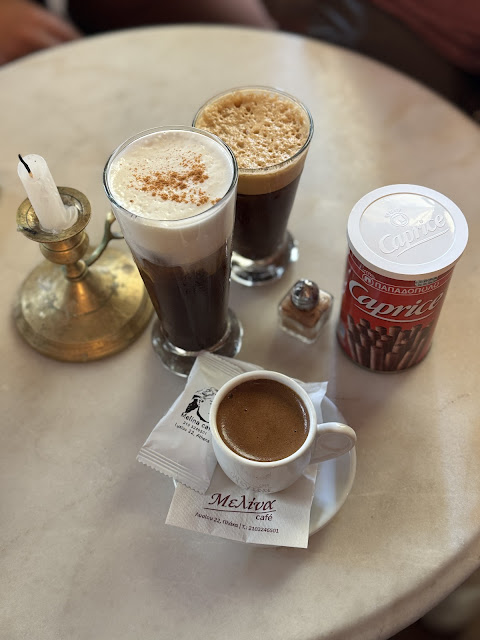 |
| I was the only one who opted for the traditional Greek coffee, which is essentially Turkish coffee! |
Afterward, we stopped at Malotira, a boutique deli specializing in high-quality Greek olive oils and traditional products from small, local producers across Greece for an olive oil tasting.
From there, we walked to Meat the Greek for some souvlaki, the most common street food in Greece.
On our way to the next stop, we passed through the Church of Virgin Mary Gorgoepekoos and Saint Eleutherius (commonly known as the Little Metropolis).
We also passed by the larger Holy Metropolitan Church of the Annunciation to the Virgin Mary, which features beautiful frescoes above the archways.
We then walked towards the Central Market for a cheese and Greek yogurt tasting (the best yogurt you'll ever have, hands down!) before moving on to our dessert stops...
Our first dessert stop was Krinos, renowned for its loukoumades, Greek style donuts drenched in honey syrup and sprinkled with cinnamon. Established in 1922, Krinos has become an iconic spot for both locals and visitors seeking a taste of traditional Greek sweets.
Our next stop was Crème Royale, a fairly new bakery established in 2015. here we tried the custard-filled bougatsa, a creamy dessert pastry. This one was perhaps my favorite!
Our last dessert stop was Kokkion for some traditional Greek ice cream. Here we tried kaimaki, a classic Greek flavor made with buffalo milk and mastic (a resin from the mastic tree found mainly on the Greek island of Chios, which contributes to the subtle piney aroma).
Stomachs full, we shopped on our own in Plaka and had a few hours at leisure to let our stomachs recover before we had more food for dinner! For dinner, we went to Taratsa which blends Greek flavors with Levantine influences from countries like Lebanon, Jordan, and Syria.
We didn't order much, and I was still hungry after dinner, so I made a quick detour to Not Just Falafel, a place I had visited in 2019, for a late night falafel wrap. Surprisingly, it was still the same people working there and yes, it was just as good!
The following morning we bid farewell to Athens and hopped on our scheduled flight to Santorini. Santorini is a stunning Greek island in the Aegean Sea, famous for its dramatic volcanic landscape, whitewashed buildings, and breathtaking sunsets. Known for its charming villages like Oia and Fira perched on cliffs overlooking the caldera, people come for the crystal-clear waters, local wines, and unforgettable views. It's truly one of the most iconic destinations in Greece, and I can easily see why!
When we arrived, we visited two of the Canaves properties and had one of the best lunches of the entire trip: Greek salad, bread with hummus, whipped cod roe, and tzatziki, calamari, pasta with mussels and sea urchin, and more. Pics below... try not to drool!
Stomachs full once again (a common theme in Greece), we checked into the stunning Canaves Oia Epitome perched above the fishing village of Ammoudi just outside the picturesque town of Oia. When we got to our room, I was blown away. With two levels of chic, Greek modern decor, and expansive patio overlooking the ocean, we also had a private pool. So, naturally, we had a little dip in our free time. Villa tour below!
 |
| View of our pool from one room. |
 |
| Our private pool. |
Later that afternoon, we set off for a tour of Santorini's highlights. Thankfully it wasn't a cruise ship day, and we were able to stop at the Three Bells of Fira with no other people there. Officially known as the Catholic Church of the Dormition of the Virgin Mary, it's a Greek Catholic church located in Firostefani, a village situated between Fira and Oia.
Renowned for its striking blue dome and iconic three-bell tower, the church offers panoramic views of the Aegean Sea and the caldera, making it one of the most photographed landmarks on the island.
 |
| View from the Three Bells of Fira. |
The site has a rich history dating back to the mid-17th century, when two modest cave churches were carved into the caldera cliffs. These early structures were eventually eroded due to natural forces. In the 18th century, the site was repurposed as an infirmary and later occupied by Jesuit priests. The current church was constructed in 1757 and has undergone several refurbishments over the centuries, including significant restoration after the 1956 Amorgos earthquake. The church exemplifies traditional Cycladic architecture, characterized by its whitewashed walls and blue dome. The three-bell tower is a distinctive feature, symbolizing the Holy Trinity. The church's location atop the caldera provides unobstructed views of the surrounding landscape, and was definitely my favorite viewpoint in Santorini.
From there, we visited Megalachori, one of Santorini's most picturesque villages known for its peaceful atmosphere, narrow cobbled streets, and neoclassical and Cycladic architecture. The village is home to historic mansions, underground cave houses, and several impressive churches with ornate bell towers. Some photos are below.
Afterward, we visited Venetsanos Winery, a historic and architectural gem situated in Megalochori right on the caldera cliffs. We first had to take in the views!
Established in 1947 by the Venetsanos family, it holds the distinction of being the island's first industrial winery. Notably, the winery was designed to utilize gravity in its winemaking process, minimizing the need for electricity—a remarkable feat during that era when power sources were scarce. Using the island's naturally steep slopes, grapes were delivered at the top level where they were crushed. The juice flowed downwards through the building, passing through different stages of fermentation and storage. Each level of the winery was dedicated to a specific phase of production, allowing gravity to move the wine instead of pumps. This gravity-fed process minimized mechanical intervention, preserving the delicate qualities of the grapes and resulting in cleaner, more expressive wines. It was also remarkably energy-efficient—crucial during a time when electricity was limited and expensive in Santorini. Today, the winery continues to produce high-quality wines and also serves as a cultural and event space.
 |
| The outside of the winery. |
Descending down a steep staircase, we made our way down the different levels, ending up on a beautiful cobbled patio overlooking the caldera. We were presented with a plate of local meats and cheese, and we sampled four different wines.
 |
| Descending down the staircase. |
 |
| Passing through the various rooms. |
 |
| The outdoor patio. |
Immediately following our wine tasting, we drove to Metaxi Mas for (surprise) more food. The beloved tavern is nestled in the village of Exo Gonia, renowned for its authentic blend of Cretan and Santorinian cuisines. The name "Metaxi Mas" means "between us", reflecting the restaurant's warm, familial atmosphere where guests are treated like friends. We dined on strawberry almond salad, Greek salad, goat cheese with honey and olive oil, mushrooms sautéed with herbs, moussaka, and potatoes with herbs.
 |
| Goat cheese with honey and olive oil. |
 |
| Moussaka. |
 |
| The cats really surrounded our table at this restaurant! |
To end the night, we walked back through Oia's old town to see Santorini lit up. With the tiered hotels on the cliff's edge, it was a beautiful sight.
The next morning, we had a poolside breakfast where I learned a Greek açai bowl is not what we think... it was berry yogurt with walnuts and berries!
Following breakfast, we left the hotel for our private catamaran cruise.
 |
| Backside of the boat, which also functioned as the outdoor dining room. |
 |
| Inside of the boat, near the kitchen. |
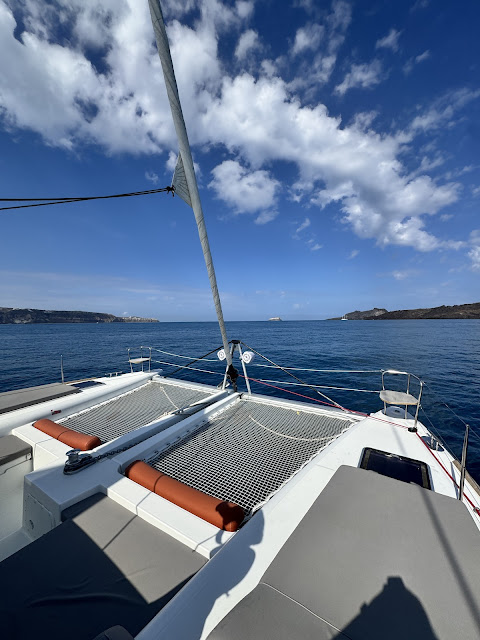 |
| This was my favorite area of the boat, but you could only be on the nets while we were not moving! |
Because the waves were choppy outside of the caldera, we decided to stay within the caldera. We stopped at the volcanic hot springs where we swam in the (very cold) sulphuric waters.
 |
| Making our first stop. |
 |
| I loved the color of the water! |
 |
| Because it was so cold (and just because), the crew gave us pool noodles. |
We then sailed past different villages, pictured below.
We even stopped for a delicious Greek barbecue lunch prepared for us via the onboard barbecue!
We ended our sailing adventure by sailing under Oia, offering us a different perspective of where we were staying.
 |
| Ammoudi and Oia. |
 |
| The town of Oia. |
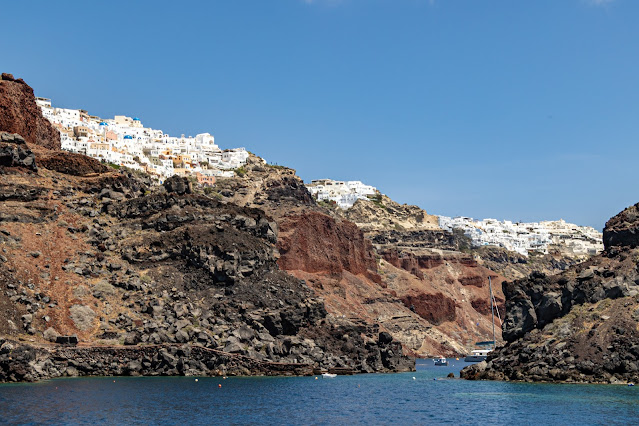 |
| Sailing back towards the port. |
 |
| We passed this small church which was on an island, so you have to take a small boat to get to it! |
A highlight of the trip, the catamaran was one of the most relaxing experiences I've had in all my travels.
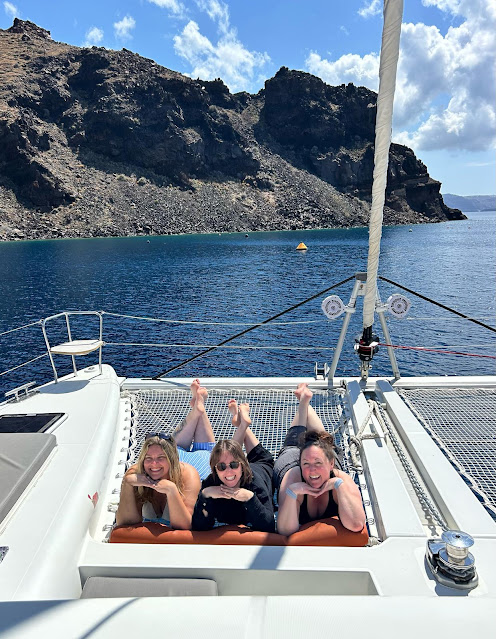 |
| Pure bliss! |
When we returned to our hotel, we saw some different room categories to gain some additional property knowledge before we had a beautiful sunset dinner at the on-site restaurant. Of course, we had a little sunset photo shoot, too!
...Get ready for more food pics!
 |
| Tuna tartare. |
 |
| Lobster risotto. |
 |
| Octopus. |
 |
| The pool at night. |
Early the next morning, we boarded our Cessna Grand Caravan 208 EX private charter flight for Chania. Chania is a charming coastal city located on the island of Crete known for its rich history, beautiful architecture, and stunning natural surroundings. The city’s Old Town features narrow, winding streets, Venetian-era buildings, and a picturesque harbor that reflects the blend of Venetian, Turkish, and Greek influences throughout its history.
Our first stop was the 17th-century Monastery of Agia Triada Tzagarolon on the Akrotiri Peninsula. Established in the 17th century by brothers Ieremias and Lavrentios Tsagarolon, members of a prominent Venetian-Cretan family, the monastery stands as a prime example of the Cretan Renaissance. Ieremias, a scholar and architect, designed the monastery's structure, drawing inspiration from the Italian architect Sebastiano Serlio. Construction commenced in 1611 but faced interruptions due to the Ottoman occupation in 1645 and subsequent events. The monastery was eventually completed in 1836, with the belfry added in 1864.
Architecturally, the monastery features a cruciform Byzantine-style church with three domes, flanked by two smaller chapels dedicated to Zoodochos Pigi and Saint John the Theologian. The complex includes a refectory, library, monks' cells, and a large cistern for water storage. Some photos are below.
A notable feature is the underground ossuary beneath the main church. Today, Agia Triada Tsagarolon remains an active monastic community and a center for religious and cultural heritage. The monks produce and sell organic products, including olive oil, wine, honey, vinegar, and olive oil soap (which we got to sample, of course!)
From there, we drove to the Fortress of Koules, built in the early 16th century to protect the harbor from pirates and invading forces.
 |
| View from the fortress. |
 |
| Rainy day fun. |
After our quick photo stop, we visited a ceramic studio of the renowned Manousos Chalkiadakis. He renovated an 18th century Venetian ruin in the village of Paidohori, which now houses both his workshop and his home. Seeing the quantity of his work was impressive!
After a traditional Cretan lunch at a local taverna, we checked into the beautiful Casa Delfino hotel. Housed in a restored 17th century Venetian mansion, the hotel is just steps from the waterfront. See below for a room photo and the view from the rooftop!
 |
| Dolphins in the courtyard entrance. |
 |
| My room. |
After dinner in old town Chania, we called it a night and prepared for another full day of adventures (and eating). The following day was our first leisurely morning of the trip. After a lazy start to the day with a later breakfast, I had a great back massage.
Feeling refreshed, I was ready to start the day... with another winery visit (because when in Greece). Manousakis Winery, located in the village of Vatolakkos near Chania, Crete, is a family-owned winery renowned for producing high-quality, organic wines under the brand name Nostos Wines. Established in 1993 by Ted Manousakis, the winery was founded upon his deep-rooted connection to his Cretan heritage and a desire to revive traditional winemaking practices. The name "Nostos," meaning "the yearning to return home," reflects this sentiment and today the winery offers tours of their storage rooms and bottling facilities providing insight into the winemaking process. Some photos are below!
 |
| Upstairs level of the winery. |
 |
| Downstairs level of the winery. |
 |
| Some of their fun labels. |
From there, we visited Biolea, an ecological prototype farm run by a family that has been cultivating the land for six generations. After learning about the traditional methods of organic olive oil prouction including stone milling and cold pressing, we had an olive oil tasting followed by one of the best meals of my life.
 |
| This fun color wheel was used to describe the tastes of the olive oils. |
For the meal, we started off with an appetizer featuring different olive oils and tomatoes.
We then had a tomato salad with pickled red onion, olives, and olive oil...
...A salad with zucchini, raw artichoke, pistachio, fava bean, avocado, wild asparagus and Biolea's signature lemon olive oil...
...The best bruschetta of my entire life...
...A lentil salad made with apple, pomegranate, beet root, olives, radish, and beet juice crackers topped with feta mousse...
...Minoan bread with three cheeses and drenched in olive oil. To serve it, they rub sage onto the bread after pouring olive oil all over the top and then they dip the sage into the salt and continue to rub the sage and salt across the top. It was easily the best bread of my entire life!
For dessert, we had carob crumble (made from the pods of the carob tree) with mzithra cheese, marmalade, and basil.
Stomachs full once more, we had the remainder of the afternoon at leisure where we did a little shopping damage in Chania's Old Town. By now, we were "fooded out", so we skipped dinner altogether!
 |
| Walking around Chania's Old Town. |
The following morning, we flew back to Athens and drove toward the greater Peloponnese. Along the way, we stopped at the Corinth Canal, a narrow man-made waterway in Greece that cuts through the Isthmus of Corinth, connecting the Aegean Sea to the Ionian Sea and separating the Peloponnese from the mainland.
 |
| Corinth Canal as seen from an overpass. |
After a delicious sea side lunch featuring local seafood, we arrived in Arcadia. Often regarded as a symbol of rural beauty and tranquility, Arcadia has long been celebrated in Greek mythology and literature as the idealized home of shepherds, pastoral life, and harmony with nature. It is an area of rugged mountains, dense forests, and fertile valleys, and is famous for its association with the Greek god Pan, the god of the wild, who was believed to reside in the region's forests and hills.
Here, we checked into MANNA, a former sanatorium turned into a luxury, 5-star boutique mountain resort. Dating back to 1927, the historical building was initially built by Anna Mela Papadopoulou, an aristocrat who gave up her bourgeois lifestyle and devoted her life to the treatment of wounded soldiers and patients with tuberculosis.
 |
| The view from the room. |
Before dinner at one of the oldest taverns in the area, we made a quick detour to Lasta, a tiny abandoned village with only a single coffee shop which also functions as a folk museum. With a population of around 2,500 during the Ottoman era, today it's considered deserted though its traditional character featuring stone-build houses, a tree-shaded square, and the Church of St. George still remains. Photos below.
The following day, we explored the mountain villages of Stemnitsa, Dimitsana, and Lagadia. Located on the western sloped of Mount Mainalo, Stemnitsa is known for its stone-built mansions, cobbled alleys, and rich history. The architecture features red-tiled roofs, wooden balconies, and the village was once a major center for silversmithing.
After walking around, we drove down a narrow, winding road to the Monastery of Prodromos.
 |
| If you look closely, you can see the road. |
 |
| When we got to the car park and view point, it was SUPER windy! |
From the car park, we hiked to the monastery of Prodromos, nestled into the cliffs of the Lousios Gorge near the villages of Dimitsana and Stemnitsa.
 |
| Hiking down to the monastery. |
The monastery was founded in the early 16th century (around 1530) by monks seeking seclusion and spiritual solitude, and it played a significant role during the Greek War of Independence (in 1821) when it was used as a refuge and a hospital for wounded fighters. Today, it is still active, home to a small community of monks who maintain a life of prayer and hospitality. While you can't take photographs inside, you can take photos from the outside and from the balcony, pictured below.
 |
| Fountain outside the monastery. |
 |
| Walking up to the monastery. |
 |
| We climbed up through a narrow staircase that led out onto a patio with bells. |
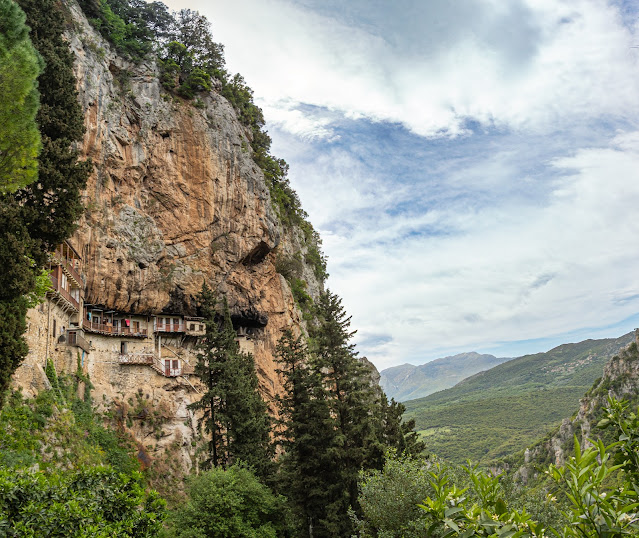 |
| From the patio, we were able to have a great panoramic view. |
 |
| Close up of the monastery. I stuck my camera out the railing! |
After our hike, we drove to Dimitsana, which was once a key center of the Greek War of Independence. Some photos from the town are below.
We ended our day in Lagadia for a very late (3 PM) lunch. Lagadia is known for its dramatic setting, traditional stone architecture, and artisan heritage and is often also called the "balcony of the Peloponnese". Afterward, we returned to the hotel where we looked at different room categories and had dinner with the owner... a beautiful last family-style meal where I was so excited by the presentation of the food that I forgot to take photos!
At 5 AM the following morning, it was finally time to bid Greece farewell after a wonderful yet exhausting trip.
Thanks for following along with our adventures. As always, follow my Instagram @elissatitle for photos and stay tuned for more!

















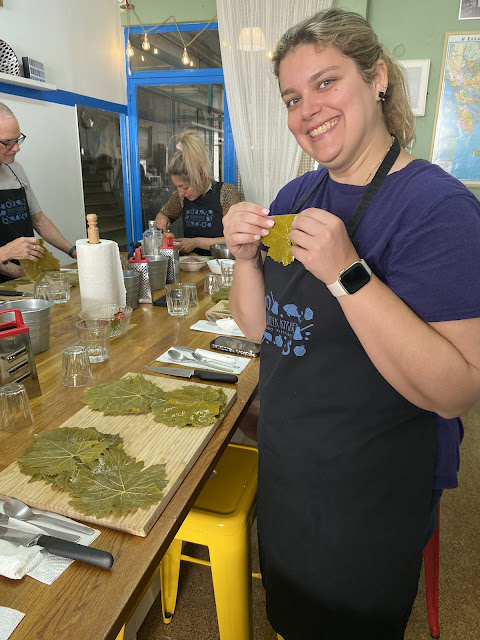

















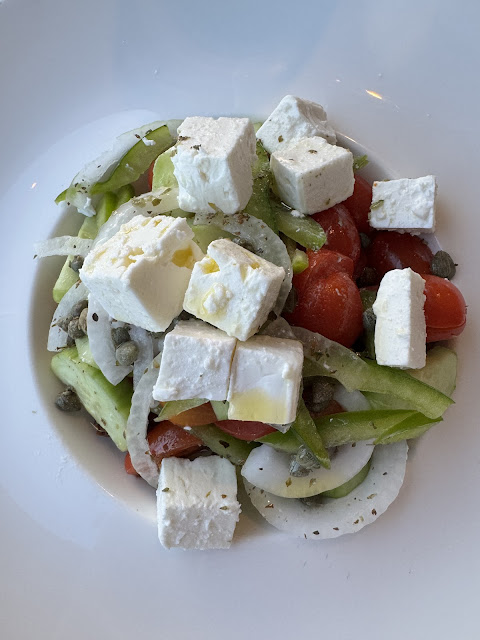
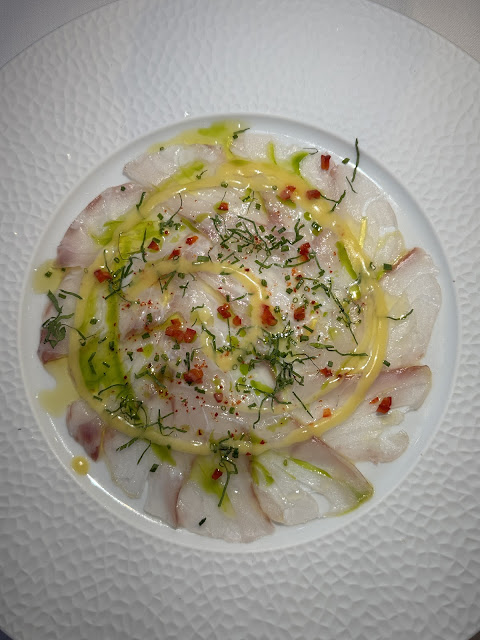



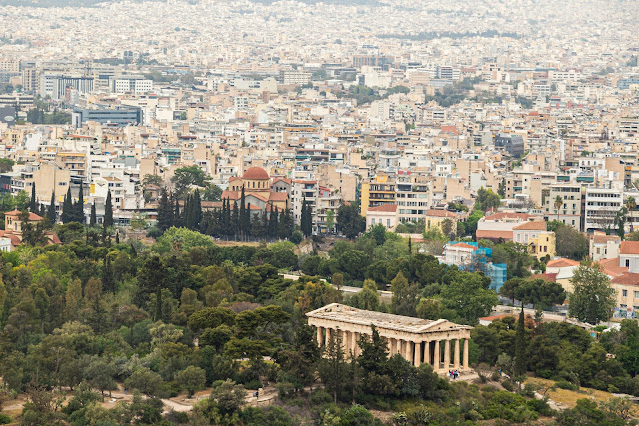




























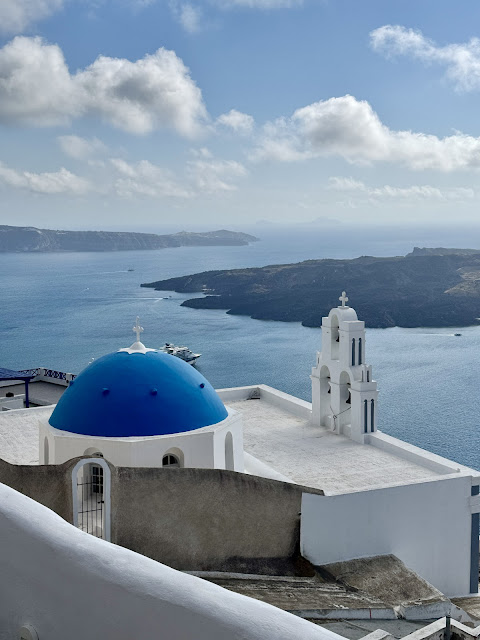








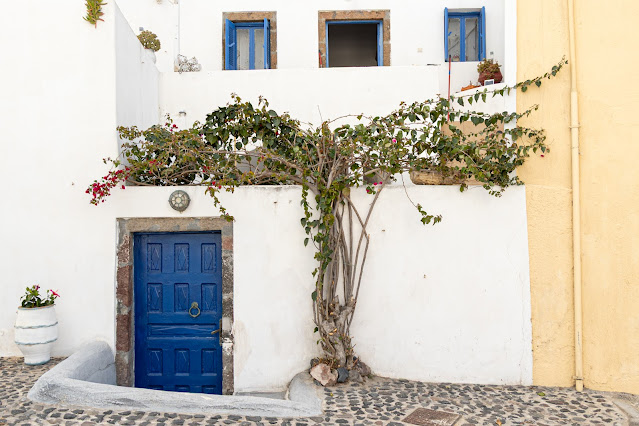






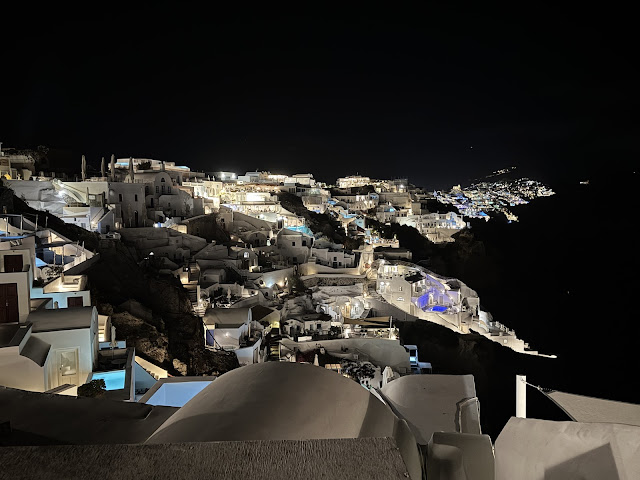












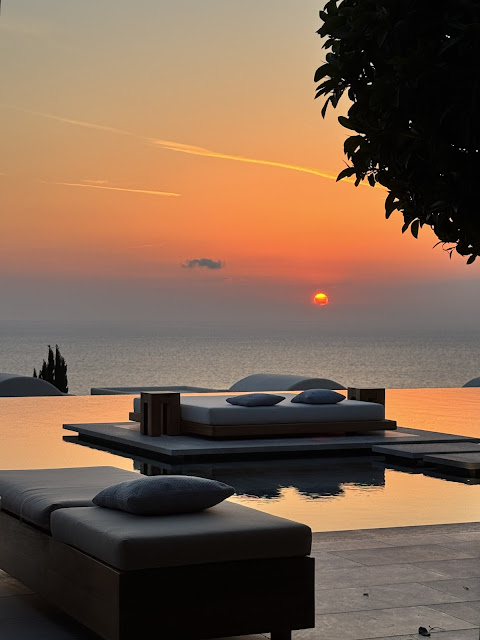

































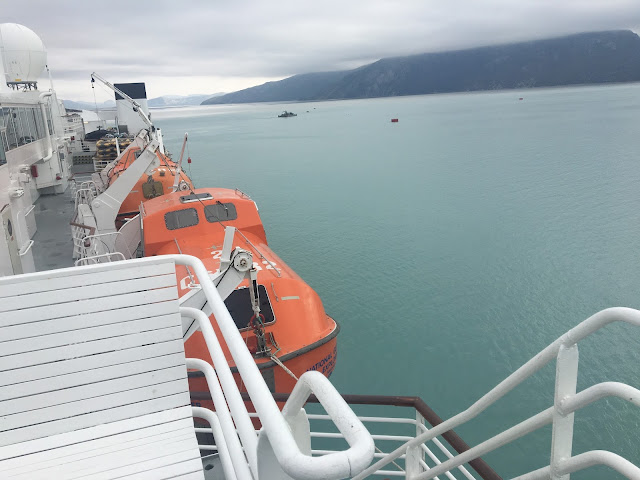

.jpg)

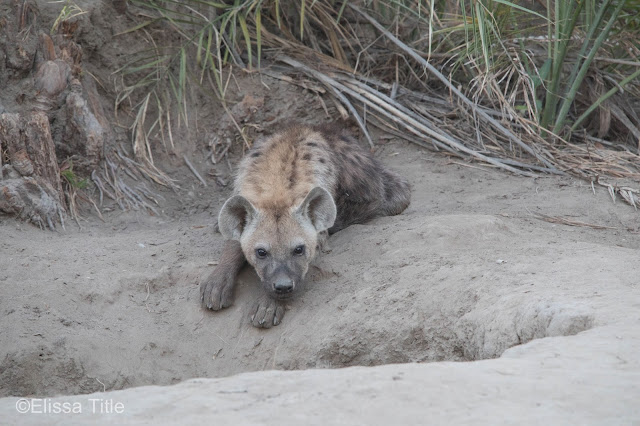

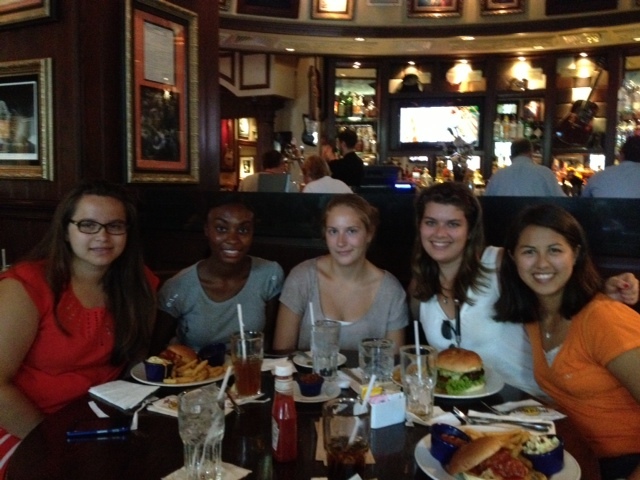

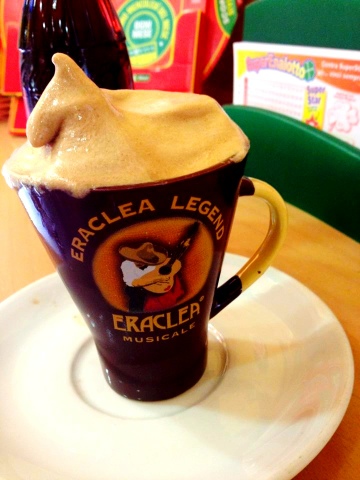
Comments
Post a Comment